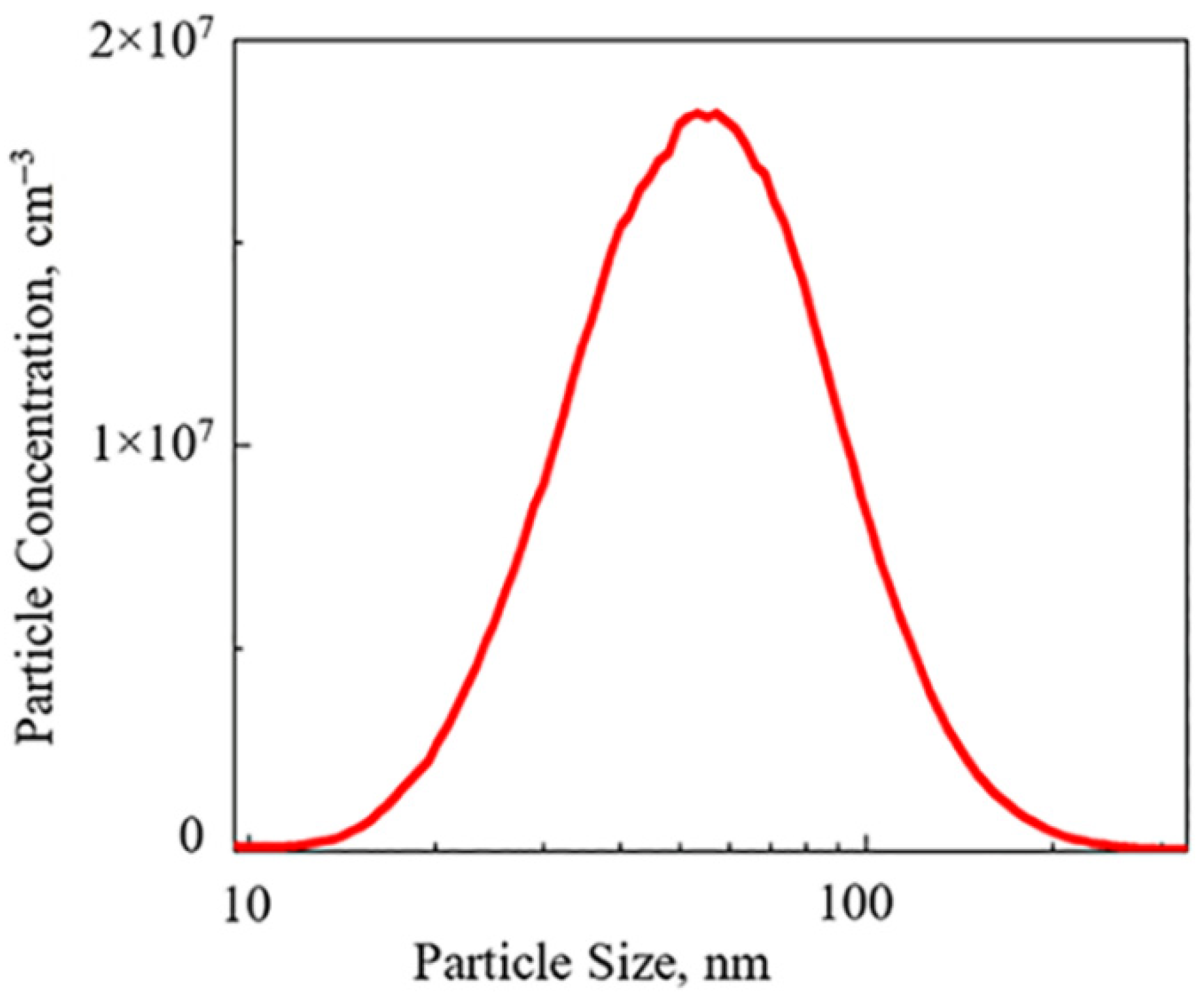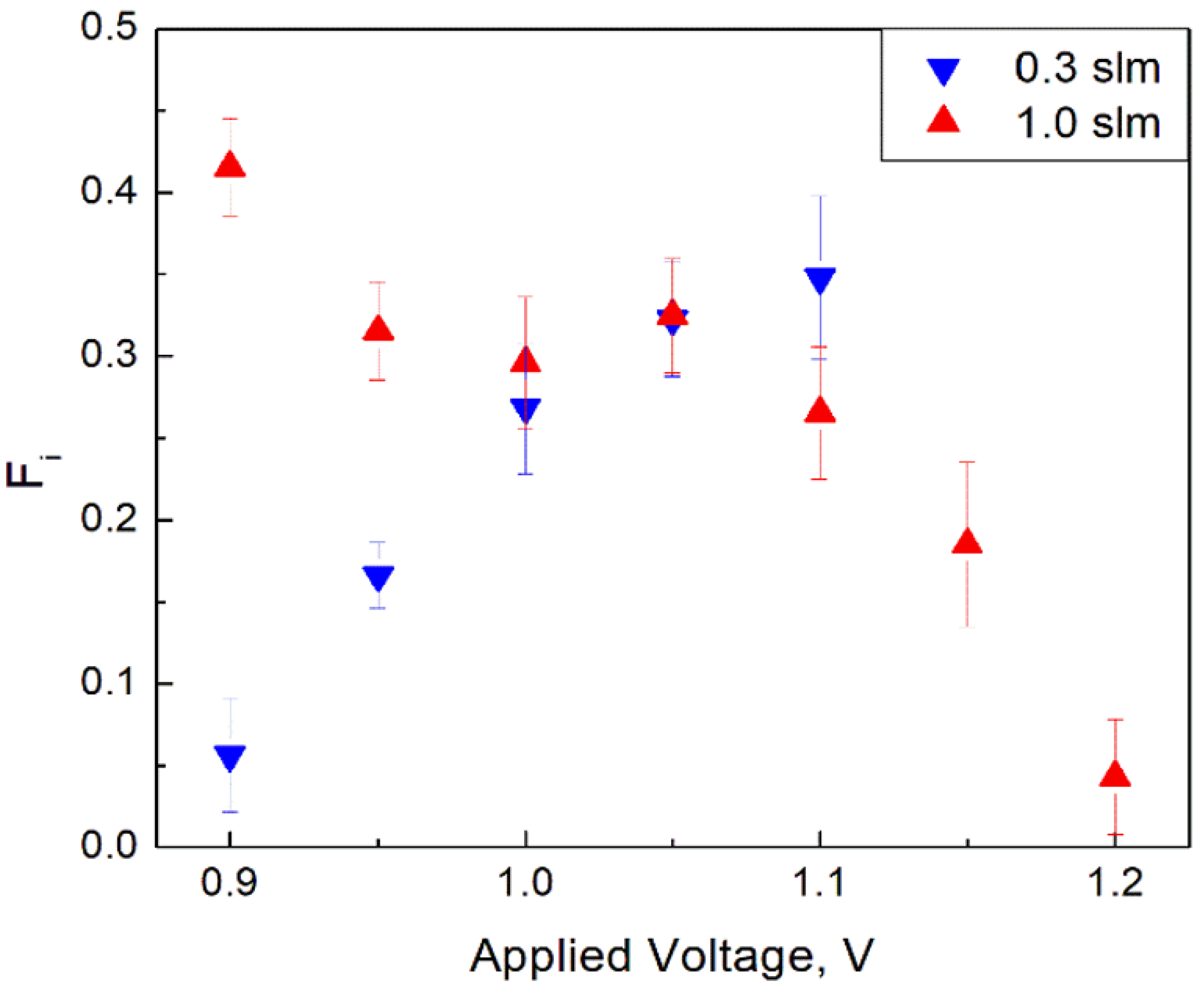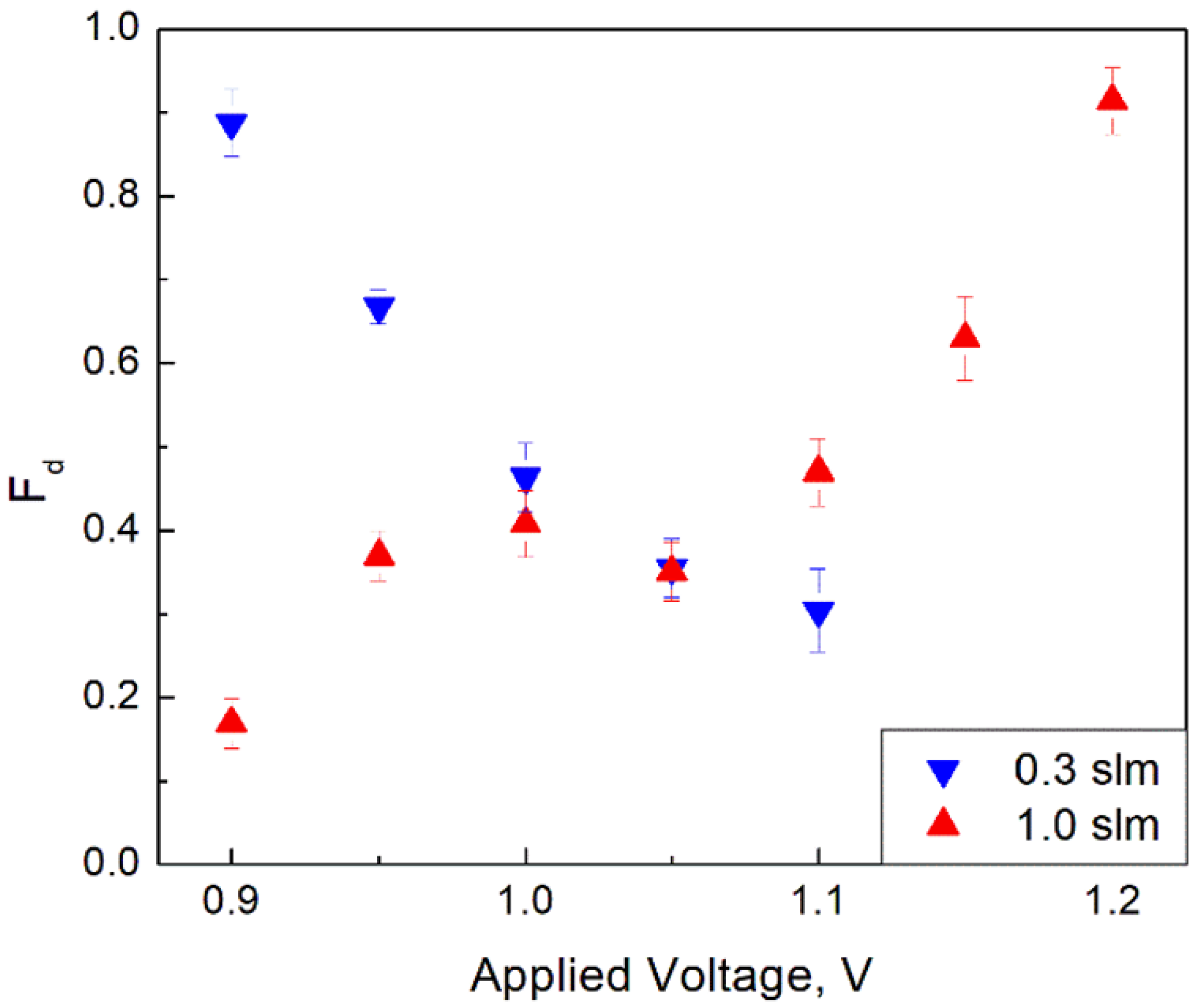Nanoparticle Generation in Glowing Wire Generator: Insight into Nucleation Peculiarities
Abstract
1. Introduction
2. Materials and Methods
3. Results and Discussion
4. Concluding Remarks
Author Contributions
Funding
Institutional Review Board Statement
Informed Consent Statement
Data Availability Statement
Conflicts of Interest
References
- Wang, Y.; Sharma, G.; Koh, C.; Kumar, V.; Chakrabarty, R.; Biswas, P. Influence of flame-generated ions on the simultaneous charging and coagulation of nanoparticles during combustion. Aerosol Sci. Technol. 2017, 51, 833–844. [Google Scholar] [CrossRef]
- Shimizu, Y. Diameter control of gold nanoparticles synthesised in gas phase using atmospheric-pressure H2/Ar plasma jet and gold wire as the nanoparticle source: Control by varying the H2/Ar mixture ratio. AIP Adv. 2017, 7, 015316. [Google Scholar] [CrossRef]
- Pfeiffer, T.V.; Feng, J.; Schmidt-Ott, A. New developments in spark production of nanoparticles. Adv. Powder Technol. 2014, 25, 56–70. [Google Scholar] [CrossRef]
- Chen, H.; Zhang, Z. Condensation-type quasi monodisperse aerosol generator with WOx nanoparticles as nuclei produced by glowing wire method. Powder Technol. 2017, 313, 344–352. [Google Scholar] [CrossRef]
- Dzimitrowicz, A.; Greda, K.; Lesniewicz, T.; Jamroz, P.; Nyk, M.; Pohl, P. Size-controlled synthesis of gold nanoparticles by a novel atmospheric pressure glow discharge system with a metallic pin electrode and a flowing liquid electrode. RSC. Adv. 2016, 6, 80773–80783. [Google Scholar] [CrossRef]
- Schmidt-Ott, A.; Schurtenberger, P.; Siegmann, H.C. Enormous yield of photoelectrons from small particles. Phys. Rev. Lett. 1980, 45, 1284–1287. [Google Scholar] [CrossRef]
- Peineke, C.; Attoui, M.; Robles, R.; Reber, A.; Khanna, S.; Schmidt-Ott, A. Production of equal sized atomic clusters by a hot wire. J. Aerosol Sci. 2009, 40, 423–430. [Google Scholar] [CrossRef][Green Version]
- Dames, P.; Gleich, B.; Flemmer, A.; Hajek, K.; Seidl, N.; Wiekhorst, F.; Eberbeck, D.; Bittmann, I.; Bergemann, C.; Weyh, T.; et al. Targeted delivery of magnetic aerosol droplets to the lung. Nat. Nanotechnol. 2007, 2, 495–499. [Google Scholar] [CrossRef]
- Sabbagh, F.; Kiarostami, K.; Khatir, N.M.; Rezania, S.; Muhamad, I.I. Green synthesis of Mg0. 99 Zn0. 01O nanoparticles for the fabrication of κ-Carrageenan/NaCMC hydrogel in order to deliver catechin. Polymers 2020, 12, 861. [Google Scholar] [CrossRef]
- Ohtaka, A. Recent progress of metal nanoparticle catalysts for C-C bond forming reactions. Catalysts 2021, 11, 1266. [Google Scholar] [CrossRef]
- Zuo, Y.; Carter-Searjeant, S.; Green, M.; Mills, L.; Mannan, S.H. Low temperature Cu joining by in situ reduction-sintering of CuO nanoparticle for high power electronics. Adv. Powder Technol. 2020, 31, 4135–4144. [Google Scholar] [CrossRef]
- Al Shboul, A.M.; Izquierdo, R. Printed chemiresistive In2O3 nanoparticle-based sensors with ppb Detection of H2S gas for Food packaging. ACS Appl. Nano Mater. 2021, 4, 9508–9517. [Google Scholar] [CrossRef]
- Ramulu, B.; Sekhar, S.C.; Arbaz, S.J.; Nagaraju, M.; Yu, J.S. Nickel-cobalt phosphate nanoparticle-layer shielded in-situ grown copper-nickel molybdate nanosheets for electrochemical energy storage. Energy Storage Mater. 2022, 44, 379–389. [Google Scholar] [CrossRef]
- Mourdikoudis, S.; Kostopoulou, A.; LaGrow, A.P. Magnetic nanoparticle composites: Synergistic effects and applications. Adv. Sci. 2021, 8, 2004951. [Google Scholar] [CrossRef]
- Khan, A.; Modak, P.; Joshi, M.; Khandare, P.; Koli, A.; Gupta, A.; Anand, S.; Sapra, B.K. Generation of high-concentration nanoparticles using glowing wire technique. J. Nanoparticle Res. 2014, 16, 2776. [Google Scholar] [CrossRef]
- Ghosh, K.; Tripathi, S.N.; Joshi, M.; Mayya, Y.S.; Khan, A.; Sapra, B.K. Particle formation from vapors emitted from glowing wires: Theory and experiments. Aerosol Sci. Technol. 2020, 54, 243–261. [Google Scholar] [CrossRef]
- Altman, I.; Agranovski, I.; Choi, M. On nanoparticle surface growth: MgO nanoparticle formation during a Mg particle combustion. Appl. Phys. Lett. 2004, 84, 5130–5132. [Google Scholar] [CrossRef]
- Altman, I.; Agranovski, I.; Choi, M. Nanoparticle generation: The concept of a stagnation size region for condensation growth. Phys. Rev. E 2004, 70, 062603. [Google Scholar] [CrossRef]
- Fomenko, E.; Altman, I.; Agranovski, I.E. On anomalous nanoparticle size evolution in glowing wire generator. Nano Struct. Nano Objects 2021, 26, 100693. [Google Scholar] [CrossRef]
- Boskovic, L.; Agranovski, I.E. An influence of a gas velocity on morphology of molybdenum oxide nanoparticles generated by a glowing wire generator. J. Aerosol Sci. 2013, 63, 69–74. [Google Scholar] [CrossRef]
- De Iuliis, S.; Dondè, R.; Altman, I. Advancement in comprehending the evolution of nanooxides in flames using laser irradiation. Chem. Phys. Lett. 2021, 139213. [Google Scholar] [CrossRef]





Publisher’s Note: MDPI stays neutral with regard to jurisdictional claims in published maps and institutional affiliations. |
© 2021 by the authors. Licensee MDPI, Basel, Switzerland. This article is an open access article distributed under the terms and conditions of the Creative Commons Attribution (CC BY) license (https://creativecommons.org/licenses/by/4.0/).
Share and Cite
Fomenko, E.; Altman, I.; Boskovic, L.; Agranovski, I.E. Nanoparticle Generation in Glowing Wire Generator: Insight into Nucleation Peculiarities. Materials 2021, 14, 7775. https://doi.org/10.3390/ma14247775
Fomenko E, Altman I, Boskovic L, Agranovski IE. Nanoparticle Generation in Glowing Wire Generator: Insight into Nucleation Peculiarities. Materials. 2021; 14(24):7775. https://doi.org/10.3390/ma14247775
Chicago/Turabian StyleFomenko, Elena, Igor Altman, Lucija Boskovic, and Igor E. Agranovski. 2021. "Nanoparticle Generation in Glowing Wire Generator: Insight into Nucleation Peculiarities" Materials 14, no. 24: 7775. https://doi.org/10.3390/ma14247775
APA StyleFomenko, E., Altman, I., Boskovic, L., & Agranovski, I. E. (2021). Nanoparticle Generation in Glowing Wire Generator: Insight into Nucleation Peculiarities. Materials, 14(24), 7775. https://doi.org/10.3390/ma14247775






